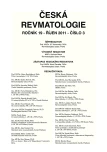Mikulicz´s disease with unilateral exophtalmia – IgG4 related disease
Authors:
Hrnčíř Zb 1; J. Laco 2; R. Slezák 3; E. Rencová 4; M. Drahošová 5; J. Brtková 6
Authors‘ workplace:
II. interní klinika, oddělení revmatologie a klinické farmakologie, 2Fingerlandův ústav patologie, 3Stomatologická klinika, 4Oční klinika, 5Ústav klinické imunologie a alergologie, 6Radiodiagnostická klinika, Lékařská fakulta UK a Fakultní nemocnice, Hrad
1
Published in:
Čes. Revmatol., 19, 2011, No. 3, p. 125-130.
Category:
Case Report
Overview
A 63 y/o woman was examined for painless enlargement of both submandibular sialic glands, lasting about four past years. Within two past years it was associated with insidious exophtalmia of the right eye and with swelling of face below this eye. Deficiency of lacrimal capacity, but normal salivation were found by functional tests. Anti SSA/Ro and anti SSB/La antibodies were negative. MR scan demonstrated bilateral enlargement of lacrimal glands and orbital infiltration, both with asymetric predilection on the right site, and exophtalmia of the right eye. Excision of the right submandibular sialic gland and of the face swelling were made. Microscopic analysis demonstrated sclerosing sialadenitis and orbital infiltration, penetrating by infraorbital canaliculus into subcutaneous tissue of face. Using immunohistochemistry analysis IgG4+ plasma cells were found in excessive amount 400/l high-power field. IgG4 serum level was 44.68 g/l (82% of total IgG); paraproteinaemia was excluded. The Mikuliczęs disease with unilateral exophtalmia was diagnosed, and glucocorticoid therapy started. Maximal initial daily dose of methylprednisolone was 32 mg with gradual decrease up to 8 mg/day. The face swelling disappeared within 3 days, exophtalmia of the right eye and enlargement of the left submandibular sialic gland within 3 months. At this time the orbital MR scan was repeated: enlargement of lacrimal gland disappeared, and orbital infiltration was markedly reduced. After 6 month therapy the patient is symptomless, without exophtalmia and swelling of face, and with only moderate elevation of IgG4 in serum.
Key words:
Mikuliczęs disease, sclerosing sialadenitis, unilteral exophtalmia, IgG4-related disease, IgG4-positive plasma cells, IgG4 serum level, response to glucocorticoid therapy
Sources
1. Ihler S, Harrison JD. Mikuliczęs disease and Mikuliczęs syndrome: Analysis of the original case report of 1892 in the light of current knowledge identifies a MALT lymphoma. Oral Surg Oral Med Oral Pathol Oral Radiol Endod 2005; 100: 334-339.
2. Takano K, Yamamoto M, Takahashi H, Shinomura Y, Imai K, Himi T. Clinicopathologic similarities between Mikulicz disease and Küttner tumor. Am J Otolaryngology – Head Neck Med Surg 2010; 31: 429-434.
3. Tziofas AG, Youihou P, Moutsopoulos HM. Sjögrenęs syndrome. In: Isenberg DA, Maddison JP, Woo P, Glass D, Breedveld FC. „Oxford textbook of rheumatology“, vyd. 3, Oxford Univ. Press, 2005, Oxford, 921-933.
4. Carsons S. Sjögrenęs syndrome. In: Harris DE, Jr, Budd R.C, Firestein GS, Genovese MC, Sergent JS, Ruddy S, Sledge CB. Kelleyęs textbook of rheumatology, vyd. 7, Elsevier Science (USA), 2005, Philadelphia, 1115-1124.
5. Zen Y, Nakanuma Y. IgG4-related disease (A cross-sectional study of 114 cases). Am J Surg Pathol 2010; 34: 1812-1819.
6. Masaki Y, Dong L, Kurose N, Kitigawa K, Morikawa Y, et al. Proposal for a new clinical entity, IgG4-positive multiorgan lymphoproliferative syndrome: analysis of 64 cases of IgG4-related disorders. Ann Rheum Dis 2009;68:1310-1315.
7. Laco J, Steiner I, Holubec T, Dominik J, Holubcova Z, Vojacek J. Isolated thoracic aortitis: clinicopathological and immunohistochemical study of 11 cases. Cardiovascular Path 2010; Oct 29. doi: 10.1016/j. carpath.2010. 09. 003.
8. Yamamoto M, Harada S, Chara, M, Suzuki C, Naishiro Y, Yamamoto H, Takahashi H, Imai K. Clinical and pathological differences between Mikuliczęs disease and Sjögrenęs syndrome. Rheumatology 2005; 44: 227-234.
9. Masaki Y, Sugai S, Umehara H. IgG4-related diseases including Mikuliczęs disease and sclerosing pancreatitis: diagnostic insights. J Rheumatol 2010; 37: 1380-1385.
10. Aoki A, Sato K, Itabashi M, Takei T, Yoshida T, Arai J, Uchida K, Tsuchiya K, Nitta K. A case of Mikuliczęs disease complicated with severe interstitial nephritis with IgG4. Clin Exp Nephrol 2009; 13: 367-372.
11. Shimoyama K, Ogawa N, Sawaki T, Karasawa H, Masaki Y, Kawasaba H, Fukushima T, Wano Y, Hirose Y, Umehara H. A case of Mikuliczęs disease complicated with interstitial nephritis successfully treated by high-dose corticosteroid. Med Rheumatol 2006; 16: 176-182.
12. Suga K, Kawakami Y, Hiyama A, Hori A, Takeuchi M. F-18 FDG PET-CT findings in Mikulicz disease and systemic involvement of IgG4-related lesions. Clin Nucl Med 2009; 34: 164-167.
13. Khosroshahi A, Bloch DB, Desphande V, Stone JH. Rituximab therapy leads to rapid decline of serum IgG4 levels and prompt clinical improvement in IgG4-related systemic disease. Arthritis Rheum 2010; 62: 1755-1762.
14. Geyer JT, Desphande V. IgG4-associated sialadenitis. Curr Opin Rheumatol 2011; 23: 95-101.
15. Laco J, Ryska A, Celakovsky P, Dolezalova H, Mottl R, Tucek L. Chronic sclerosing sialadenitis (Küttner tumor) as a member of IgG4-related diseases: a clinicopathological study of 6 cases from Central Europe. Histopathology 2011; 2011; 58:1157–1163.
16. Yamada K, Kawano M, Inoue R, Hamano R, Kakuchi Y, Fujii H, Matsumura M, Zen Y, Takahira M, Yachie, Yamagishi M. Clonal relationship between infiltrating immunoglobulin G4 (IgG4)-positive plasma cells in lacrimal glands and circulating IgG4-positive lymphocytes in Mickuliczęs disease. Clin Exp Immunol 2008; 152: 432-439.
Labels
Dermatology & STDs Paediatric rheumatology RheumatologyArticle was published in
Czech Rheumatology

2011 Issue 3
Most read in this issue
- Hallux valgus in patients with rheumatoid arthritis – current surgical treatment options
- Mikulicz´s disease with unilateral exophtalmia – IgG4 related disease
- Real life results of rituximab in treatment of active rheumatoid arthritis
- Prevention of adverse gastrointestinal events of nonsteroidal anti-inflammatory drugs with proton pump inhibitors. Results of the epidemiologic study GREAT
